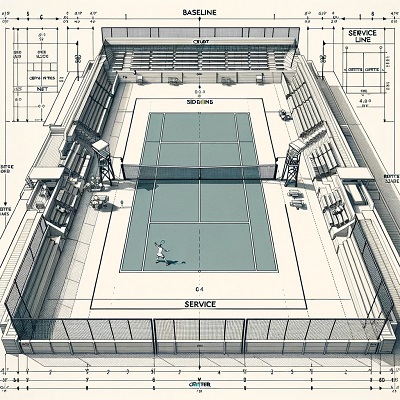Should we consider altering tennis court dimensions to evolve the game ?

In the world of sports, evolution is inevitable. From the materials used in equipment to the techniques employed by athletes, changes are continually introduced to improve performance and enhance the viewer’s experience. Tennis, a sport with a rich history dating back centuries, is no exception. One of the burning questions surrounding the future of tennis is whether altering the court dimensions could bring a fresh twist to the game. Let’s delve into the pros and cons of such a change.
Why the idea of changing dimensions?
Adapting to player physique
As the physical stature and athleticism of tennis players have evolved over the decades, there’s a growing discussion around adapting the tennis court to match these changes. Historically, tennis players were not as tall or as physically imposing as many of today’s athletes. With the increase in average height and reach, players can now serve faster, hit from greater angles, and cover the court differently than previous generations. Adjusting the court dimensions could level the playing field, ensuring that the game remains challenging and competitive for players of various physiques. Such adaptations could also encourage diverse playing styles and strategies, enriching the overall dynamics of the sport.
Enhancing viewer engagement:
The modern audience craves thrilling, fast-paced action and strategic gameplay, making viewer engagement paramount for the longevity of tennis as a spectator sport. Tweaking the court dimensions has the potential to invigorate the game, leading to longer rallies, unexpected plays, or more rapid exchanges. These changes can amplify the drama and unpredictability of matches, keeping viewers on the edge of their seats. By evolving with the times and prioritizing the spectator experience, tennis can ensure its relevance and appeal to both die-hard fans and newcomers alike, fostering a larger, more dedicated global audience.
Injury prevention
The physical demands of tennis, with its rapid directional changes, sprints, and repetitive motions, place immense strain on players’ bodies. By reconsidering court dimensions, there’s an opportunity to reduce the distances players must cover during matches, potentially decreasing the risk of overuse injuries and muscle strains. A smaller or differently shaped court could mean fewer extended rallies, less ground to cover, and a reduction in extreme lunges or dives. Conversely, a larger court could offer players more time to anticipate and react, reducing the need for abrupt, injury-prone movements. Ultimately, any modifications should prioritize players’ well-being, ensuring they can compete at their best without compromising their long-term health.
Potential drawbacks
Tradition
Tennis, with its rich heritage and storied past, is steeped in tradition that many enthusiasts hold dear. The court’s dimensions have remained consistent for over a century, bearing witness to countless epic battles, historic moments, and the evolution of playing styles. To many purists, altering these dimensions could be perceived as tampering with the very soul of the game, potentially erasing a part of its identity. While change can herald progress, it’s essential to approach it with sensitivity, ensuring that tennis’s essence and its deep-rooted traditions are not lost in the pursuit of modernization.
Infrastructure costs
Implementing changes to tennis court dimensions would have significant financial implications. Existing courts, both public and private, around the world would require modifications or complete overhauls. This entails not just the costs of physical reconstruction, but also the expenses associated with redesigning surrounding infrastructure, such as seating areas and lighting. For major tennis venues that host international tournaments, the financial burden could be particularly steep. Additionally, the transition would demand investment in training and resources to educate players, coaches, and officials about the new standards. The overarching economic impact of such a change, especially in a sport with global reach, could be monumental and would need thorough consideration.
Player adaptation
Adjusting to new court dimensions would present a significant challenge for tennis players, who have honed their skills and strategies based on the current court size. Such a change would alter the dynamics of the game, demanding players to relearn angles, adjust their serving and return techniques, and modify their movement patterns. For seasoned professionals, this could be especially jarring, as years of muscle memory and tactical understanding would suddenly be misaligned with the new environment. Younger players might adapt more quickly, but the transitional period would still require patience, resilience, and a willingness to unlearn and relearn fundamental aspects of the game. The psychological and technical implications of this adaptation process should not be underestimated.
what do the experts say?
Many tennis experts are divided on this issue. Some believe that tweaks to the court size could usher in a new era of tennis, while others argue that the current dimensions have stood the test of time for a reason.
conclusion
While the debate over altering tennis court dimensions is intriguing, it’s essential to weigh the potential benefits against the drawbacks. Any change would need to prioritize the health and safety of players, ensure fairness in competition, and enhance the viewer’s experience. Only time will tell if the tennis world is ready for such a transformation.
